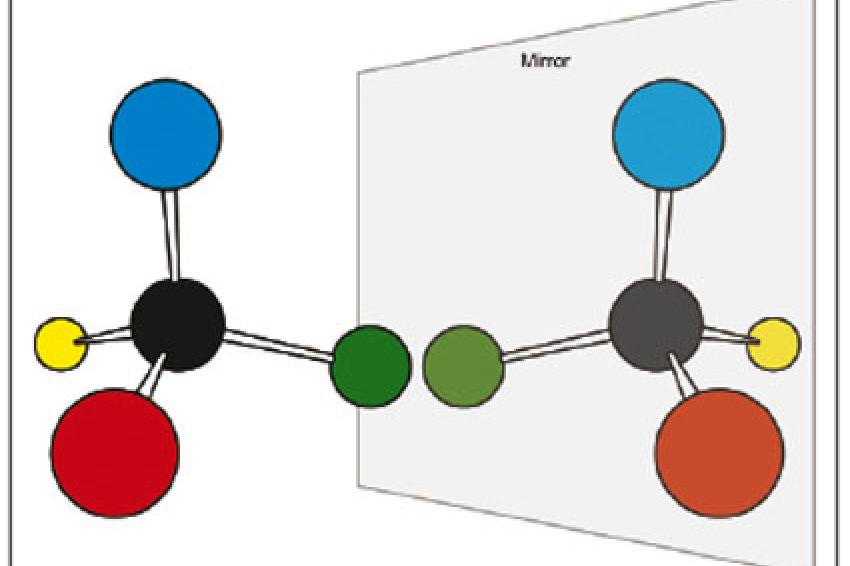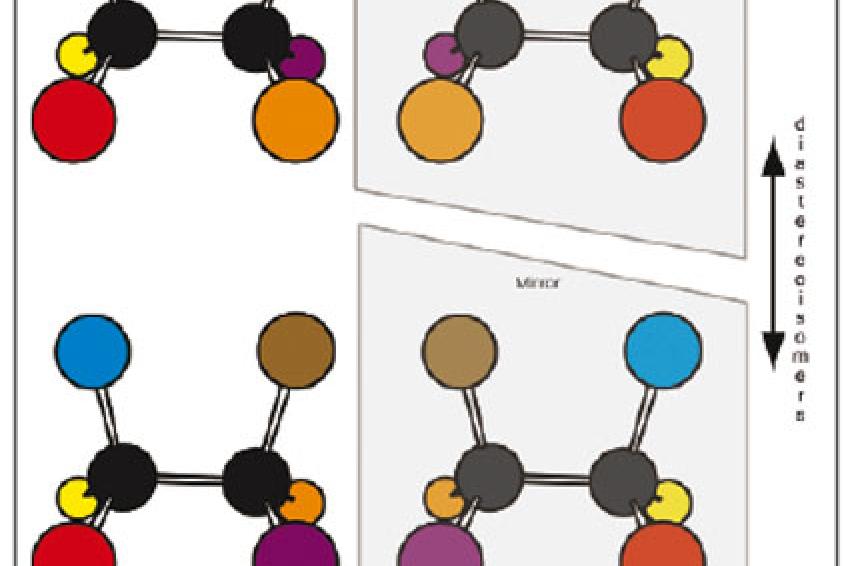Chirals: The Real Deal
Is Obtaining A Chiral Molecule A Big Problem?
Getting Easier - The number of drug candidates containing a stereogenic center continues to increase, necessitating selective syntheses of aspecific isomer. As the number of methods increases, this is becoming less onerous.
The ‘Problem'
Drugs interact with biological systems, which are chiral, or possess "handedness." When a molecule contains a stereogenic element, it can give rise to stereoisomers where groups are arranged in a different spatial manner. When a carbon atom has four different groups attached, it becomes a stereogenic center and enantiomers can exist. Enantiomers are non-superimpossible mirror images and the stereogenic center is often referred to as a chiral center (fig. 2). These enantiomers can be acted upon in different manners by another chiral molecule.
When an entity contains two chiral centers, four possible isomers are available - two sets of mirror images. The compounds that are not mirror images of one another are called diastereoisomers. These diastereoisomers have different physical properties, such as solubility and melting point and can be separated by standard methods. On the other hand, enantiomers have the same physical properties, such as solubility and melting point, unless acted upon by another chiral agent.
Although these effects have been known and understood for a long time, it is only recently that we have possessed the analytical and physical methods to make chiral - or asymmetric synthesis - a viable option.
Chiral Pool
Nature is generous in providing the "chiral pool," a range of compounds, such as amino acids, carbohydrates and terpenes, which exist as just one enantiomer and are readily available. This chiral pool is somewhat restricted, and many early asymmetric syntheses are spent in an inordinate number of steps to manipulate the functionality so that a chiral center could be incorporated into the target molecule. On the other hand, this is an efficient and cheap approach if the chiral pool material can be readily used. In a few cases, the desired compound, or a close derivative, may be available from an organism and fermentation can provide a ready supply. This approach is now helped by yield improvements through molecular biology.
Resolutions
The other traditional method to obtain chiral compounds is resolution, where a derivative, such as salt formation with another chiral molecule, is made so that the resultant diastereoisomers can be separated. A salt break then gives the single enantiomer of the desired molecule. It is also possible to make a covalent bond between the subject molecule and a chiral derivative to allow separation. The approach can be somewhat tedious, as conditions need to be found to separate the derivative diastereoisomers. A number of adaptations have been developed in recent years, including one called the "Dutch Resolution" where a mixture of chiral agents, such as acids to resolve a base, are added at the same time and a mixture of salts is obtained.
Biocatalysts can be used to resolve a racemic mixture when one enantiomer is a substrate for an enzyme while the other is not. Another methodology that has arisen from the resolution approach is to use chromatography with a chiral stationary phase. Translation to larger scale can, however, be costly as large amounts of absorbent may be required. However, this can be alleviated to a degree by the use of techniques such as simulated moving bed (SMB).
These sorts of resolutions result in a maximum of 50% yield, although it may be possible to recycle the undesired enantiomer by a racemization - interconversion of the enantiomers - procedure. This approach is often called a dynamic kinetic resolution and the result can be 100% yield of a single enantiomer (fig. 3). Separation techniques have also been developed that allow the chiral agent to be recycled and reused, often in flow systems.
Asymmetric Synthesis
Rather than perform a resolution, asymmetric synthesis is now becoming mature enough to provide competitive methodologies. The use of a chiral auxiliary or template has given some high degrees of asymmetric induction and provided mechanistic insight into a wide range of reactions. In this type of approach, a chiral moiety is attached to a substrate molecule, a reaction is performed where the stereochemical outcome of the reaction is guided by the auxiliary, and then this moiety is removed to provide the desired enantiomer of the product. The methodology is stoichiometric and, even with an auxiliary that has the potential to be recycled, can be expensive. Two extra steps are added to the synthetic sequence - attachment and removal of the auxiliary.
With chiral reagents, the stoichiometric reagent itself provides the chiral discrimination to a prochiral - a center that can form enantiomers during a reaction - substrate. In some cases, the chiral part of the reagent can be recaptured and reused, although this may involve a number of steps.
With costs and "green" methods becoming more important, current methodology is moving towards catalytic methods, be they chemical or biological. Indeed, chemical catalysis for asymmetric synthesis with a high degree of asymmetric induction as illustrated by asymmetric hydrogenations is over 40 years old. Many chemical catalysts involve the use of a transition metal with chiral ligands attached to provide a chiral "pocket" where the desired reaction occurs. High levels of selectivity can be achieved in a variety of reactions but especially reductions of carbon-carbon, carbon-oxygen and carbon-nitrogen double bonds (fig. 4). In addition, catalyst usage can be very low, making the cost contribution to the process small.
Biocatalysts can also be very efficient and provide just a single enantiomer of the product. Techniques, such as immobilization and biphasic systems, provide means to use the catalyst in more than one batch or in a continuous process.
There is a third type of catalyst called organocatalysts, which do not contain a transition metal and in many applications mimic enzyme reaction mechanisms.
The Future
Catalytic methods will continue to grow and provide many more methods for asymmetric synthesis in the years to come. Forty years ago, obtaining a single enantiomer of a product could be a major undertaking if a resolution or chiral pool approach could not be readily adapted. With the number of methods available today, asymmetric synthesis is not so much of a burden and can be considered no more onerous than making a strategic bond. Our understanding of reaction mechanisms and how reactions proceed in a three-dimensional array has helped with asymmetric reaction design.
At present, screening is often necessary to determine the best catalyst to use for a reaction. It is imaginable that this may become redundant as our knowledge increases so that a chiral catalyst can be predicted or designed in silico. The vast improvements in analytical methodologies and the decrease in time required to perform them will continue to play an important role in chiral method development.
For further reading see Handbook of Chiral Fine Chemicals, 2nd edition, David J. Ager, ed, CRC: Taylor Francis, Boca Raton, 2005.
Contact
DSM Pharmaceutical Products
45 Waterview Blvd.
Parsippany, NJ 07054-1298
+1 973 257 8011
+1 973 257 8024






